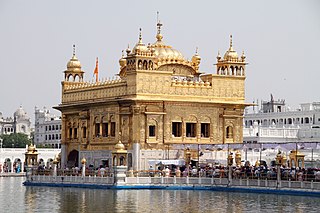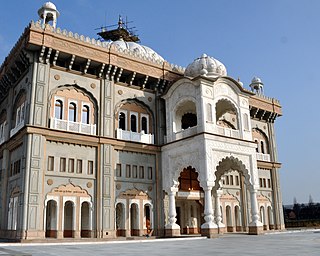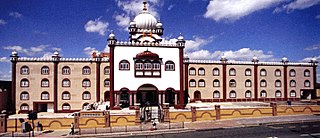
Sikhism, also known as Sikhi, is an Indian religion and philosophy in particular for the Sikh ethnoreligious group that originated in the Punjab region of India around the end of the 15th century CE. The Sikh scriptures are written in the Gurumukhi script particular to Sikhs. It is one of the most recently founded major religious groups and among the largest in the world, with about 25–30 million adherents.

A gurdwara or gurudwara is a place of assembly and worship for Sikhs but its normal meaning is place of guru or "Home of guru". Sikhs also refer to gurdwaras as Gurdwara Sahib. People from all faiths and religions are welcomed in gurdwaras. Each gurdwara has a Darbar Sahib where the Guru Granth Sahib is placed on a takht in a prominent central position. Any congregant may recite, sing, and explain the verses from the Guru Granth Sahib, in the presence of the rest of the congregation.
The following outline is provides an overview of Sikhism, or Sikhi.

The Damdamī Ṭaksāl, also sometimes referred to as Giani Samparda, Jatha Bhindra(n), or Sampardai Bhindra(n) is an orthodox Khalsa Sikh cultural and educational organization, based in India. They are known for their teachings of vidya as well as gurbanisanthiya. Its headquarters are located in the town of Mehta Chowk, approximately 40 km north of the city of Amritsar. It has been described as a seminary or “moving university” of the Sikh countryside.
Sat Sri Akaal is a Jaikara now used, often, as a greeting by Punjabi Sikhs. It is the second half of the Sikh Clarion call, given by the Tenth guru, Guru Gobind Singh, "Bole So Nihal, Sat Sri Akal".

The Akhand Kirtani Jatha, alternatively romanized as the Akhand Keertanee Jathaa and abbreviated as AKJ, is a jatha and sect of Sikhism dedicated to the Sikh lifestyle. The Jatha follows a strict discipline in keeping the Rehat of Guru Gobind Singh. They also enjoy an active style of Keertan recited by Sikhs in a collective manner in front of Guru Granth Sahib. This style of Keertan is relatively simple, and the entire congregation devotionally participates in singing along.

Sikh music, also known as Gurbani Sangeet , and as Gurmat Sangeet, or even as Shabad Kirtan, is the classical music style that is practised within Sikhism. It exists in institutional, popular, and folk traditions, forms, and varieties. Three types of Sikh musicians are rababis, ragis, and dhadhis. Sikh music exists in various melodic modes, musical forms, styles, musicians, and performance contexts.

A Granthi is a person, female or male, of the Sikh religion who is a ceremonial reader of the Guru Granth Sahib, which is the holy book in Sikhism, often read to worshipers at Sikh temples called a Gurdwara.

Gurdwara Sri Guru Singh Sabha Southall (SGSS) is a Sikh gurdwara situated on Guru Nanak Road and Park Avenue, Southall, in the London Borough of Ealing. It is the largest Sikh temple in London. Building work at the Havelock Road site commenced in March 2000 and the gurdwara opened on Sunday 30 March 2003, in order to accommodate Southall's growing Sikh community. The gurdwara cost £17.5 million to build. It was funded by donations from members of the local Sikh community.

A Sahajdhari Sikh is a person who believes in Sikhism but is not an Amritdhari. A Sahajdhari adheres to the principles of Sikhism and the teachings of the Sikh gurus but may not wear all of the Five Symbols of Sikhism. For example, Sahajdhari Sikhs often wear a kara, but many of them cut their hair (kesh).

British Sikhs number over 520,000 people and account for 0.85% of the British population as of 2021, forming the United Kingdom's fourth-largest religious group. According to the 2021 United Kingdom census, British Sikhs numbered 524,529, with 520,092 in England, 4,048 in Wales, and 389 in Northern Ireland. The largest Sikh populations in the United Kingdom are in the West Midlands and Greater London.

The Gurdwara Sahib is a Sikh place of worship or Gurdwara in Handsworth, Birmingham, England. It was built in the late 1970s under the spiritual guidance of Sant Baba Puran Singh ji and the leadership of Norang Singh. The Spiritual leadership of the jatha is now continued through the vision of Mohinder Singh.
The following list consists of concepts that are derived from both Sikh and Indian tradition. The main purpose of this list is to disambiguate multiple spellings, to make note of spellings no longer in use for these concepts, to define the concept in one or two lines, to make it easy for one to find and pin down specific concepts, and to provide a guide to unique concepts of Sikhism all in one place.
Barundi is a village located in the Ludhiana district of the state of Punjab in India. With a population of more than 4166, Barundi is one of the largest villages in Ludhiana.Barundi is also known for its state of the art drainage system and sewage treatment plant. Apart from these the village has its great religious significance too.
Followers of Sikhism do not have a preference for meat or vegetarian consumption. There are two views on initiated or "Amritdhari Sikhs" and meat consumption. "Amritdhari" Sikhs can eat meat. "Amritdharis" that belong to some Sikh sects are vehemently against the consumption of meat and eggs.
The arrival of Sikhism in Wales is relatively recent. As of the 2021 United Kingdom census there were 4,048 Sikhs in the country representing 0.1% of the population.

A Ragi is a Sikh musician who plays hymns (shabads) in different ragas as prescribed in the Sri Guru Granth Sahib.

The 52 Hukams are a set of instruction in Sikhism set by Guru Gobind Singh in Nanded, Maharashtra, India in 1708. These edicts sum up the ideal way of life of the Khalsa and serve as a code of conduct for the Khalsa Panth. Members of the Khalsa aim to follow all the 52 edicts.

Sikh sects, denominations, traditions, movements, sub-traditions, also known as sampardai in the Punjabi language, are sub-traditions within Sikhism that believe in different approaches to practicing the religion. All sampradas believe in the One Creator God typically rejecting both idol worship and caste systems. Different interpretations have emerged over time, some of which have a living teacher as the leader. The major historic traditions in Sikhism, states Harjot Oberoi, have included Udasi, Nirmala, Nanakpanthi, Khalsa, Sahajdhari, Namdhari Kuka, Nirankari and Sarvaria.

















